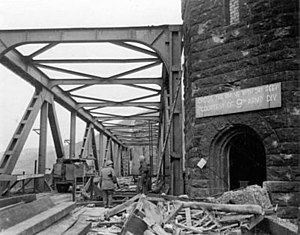Battle of Remagen
| Battle of Remagen | |||||||
|---|---|---|---|---|---|---|---|
| Part of the invasion of Germany in World War II | |||||||
 American forces cross the Ludendorff Bridge at Remagen on 8 March 1945 |
|||||||
|
|||||||
| Belligerents | |||||||
|
|
|
||||||
| Commanders and leaders | |||||||
|
|
|
||||||
| Strength | |||||||
| 1st Army | 7th Army | ||||||
Allied victory
The Battle of Remagen during the Allied invasion of Germany resulted in the unexpected capture of the Ludendorff Bridge over the Rhine and possibly shortened World War II in Europe. After capturing the Siegfried Line, the 9th Armored Division of the U.S. First Army had advanced unexpectedly quickly towards the Rhine. They were very surprised to see one of the last bridges across the Rhine still standing. The Germans had wired the bridge with about 2,800 kilograms (6,200 lb) of demolition charges. When they tried to blow it up, only a portion of the explosives detonated. U.S. forces captured the bridge and rapidly expanded their first bridgehead across the Rhine, two weeks before Operation Plunder. The GIs' actions prevented the Germans from regrouping east of the Rhine and consolidating their positions.
The battle for control of the bridge caused both the American and German forces to employ new weapons and tactics in combat for the first time. Over the next 10 days, the Germans used virtually every weapon at their disposal to try to destroy the bridge. This included infantry and armor, howitzers, mortars, floating mines, mined boats, a railroad gun, and a giant 540 mm super-heavy mortar. They also attacked the bridge using the newly developed Arado Ar 234 B-2 turbojet bombers. To protect the bridge against aircraft, the Americans positioned the largest concentration of anti-aircraft weapons during World War II leading to "the greatest antiaircraft artillery battles in American history." The Americans counted 367 different German Luftwaffe aircraft attacking the bridge over the next 10 days. The Americans claimed to have shot down nearly 30% of the aircraft dispatched against them. The German air offensive failed.
On 14 March, German Reich Chancellor Adolf Hitler ordered Schutzstaffel (SS) General Hans Kammler to fire V2 rockets to destroy the bridge. This marked the first time the missiles had been used against a tactical objective and the only time they were fired on a German target. The 11 missiles launched killed six Americans and a number of German citizens in nearby towns, but failed to damage the bridge. When the Germans sent a squad of seven naval demolition swimmers wearing Italian underwater breathing apparatus, the Americans were ready. For the first time in combat, they had deployed the top-secret Canal Defence Lights which successfully detected the frogmen in the dark, and they were all killed or captured.
...
Wikipedia
